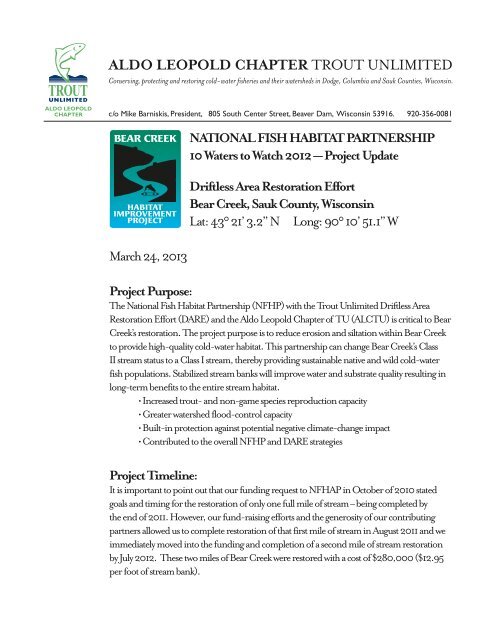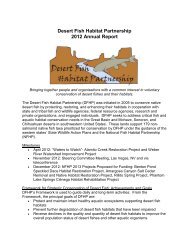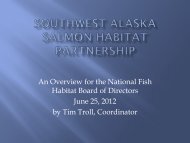aldo leopold chapter trout unlimited - National Fish Habitat Partnership
aldo leopold chapter trout unlimited - National Fish Habitat Partnership
aldo leopold chapter trout unlimited - National Fish Habitat Partnership
You also want an ePaper? Increase the reach of your titles
YUMPU automatically turns print PDFs into web optimized ePapers that Google loves.
ALDO LEOPOLD CHAPTER TROUT UNLIMITED<br />
Conserving, protecting and restoring cold-water fisheries and their watersheds in Dodge, Columbia and Sauk Counties, Wisconsin.<br />
ALDO LEOPOLD<br />
CHAPTER<br />
c/o Mike Barniskis, President, 805 South Center Street, Beaver Dam, Wisconsin 53916. 920-356-0081<br />
BEAR CREEK<br />
HABITAT<br />
IMPROVEMENT<br />
PROJECT<br />
NATIONAL FISH HABITAT PARTNERSHIP<br />
10 Waters to Watch 2012 — Project Update<br />
Driftless Area Restoration Effort<br />
Bear Creek, Sauk County, Wisconsin<br />
Lat: 43° 21’ 3.2” N Long: 90° 10’ 51.1” W<br />
March 24, 2013<br />
Project Purpose:<br />
The <strong>National</strong> <strong>Fish</strong> <strong>Habitat</strong> <strong>Partnership</strong> (NFHP) with the Trout Unlimited Driftless Area<br />
Restoration Effort (DARE) and the Aldo Leopold Chapter of TU (ALCTU) is critical to Bear<br />
Creek’s restoration. The project purpose is to reduce erosion and siltation within Bear Creek<br />
to provide high-quality cold-water habitat. This partnership can change Bear Creek’s Class<br />
II stream status to a Class I stream, thereby providing sustainable native and wild cold-water<br />
fish populations. Stabilized stream banks will improve water and substrate quality resulting in<br />
long-term benefits to the entire stream habitat.<br />
• Increased <strong>trout</strong>- and non-game species reproduction capacity<br />
• Greater watershed flood-control capacity<br />
• Built-in protection against potential negative climate-change impact<br />
• Contributed to the overall NFHP and DARE strategies<br />
Project Timeline:<br />
It is important to point out that our funding request to NFHAP in October of 2010 stated<br />
goals and timing for the restoration of only one full mile of stream – being completed by<br />
the end of 2011. However, our fund-raising efforts and the generosity of our contributing<br />
partners allowed us to complete restoration of that first mile of stream in August 2011 and we<br />
immediately moved into the funding and completion of a second mile of stream restoration<br />
by July 2012. These two miles of Bear Creek were restored with a cost of $280,000 ($12.95<br />
per foot of stream bank).
ALDO LEOPOLD<br />
CHAPTER<br />
page 2<br />
Now in 2013, ALCTU is currently raising funds for continued restoration of an adjacent<br />
section of Bear Creek. Approximately 75% of the required funding for 2013 has been<br />
secured. This future section also has a permanent access easement and is 1.15 miles in stream<br />
length. The 2013 section is immediately downstream from the NFHAP funded one mile<br />
restored in 2011 and is upstream from the previously restored (2004) Bear Creek <strong>Fish</strong>ery<br />
Unit. The Bear Creek <strong>Fish</strong>ery Unit is approximately 775 acres under Wisconsin Department<br />
of Natural Resources ownership. These 775 acres include Bear Creek and tributaries. Much<br />
of the riparian land is floodplain marsh with a limited amount of lowland timber. The<br />
NFHAP, DARE and ALCTU partnership is reconnecting fragmented and now, improved<br />
habitat to benefit the entire Bear Creek Watershed.<br />
Project Partners:<br />
During the last three years, approximately $380,000 have been raised. $260,000 has<br />
been invested in the Bear Creek restoration project. With an additional $146,000 currently<br />
secured, approximately $20,000 will need to be added for the restoration work planned for<br />
2013. Bear Creek Contributing Partners are:<br />
• Alliant Energy Foundation<br />
• Aldo Leopold Chapter TU<br />
• William Fargen Family<br />
• Badger Fly <strong>Fish</strong>ers<br />
• J. E. Dutton Foundation<br />
• Sauk County Land Conservation Department<br />
• Trout & Salmon Foundation<br />
• TU Embrace-A-Stream<br />
• USDA Wildlife <strong>Habitat</strong> Incentive Program<br />
• USFWS <strong>National</strong> <strong>Fish</strong> <strong>Habitat</strong> Action Plan<br />
• Wisconsin Department of Natural Resources<br />
• Wisconsin State Council TU
ALDO LEOPOLD<br />
CHAPTER<br />
page 3<br />
Project Updates & Changes:<br />
Many of the techniques that are being applied to the Bear Creek restoration have been<br />
proposed as adaptation strategies to help lessen the impacts of climate change, which poses a<br />
significant threat to cold water fish populations. <strong>Fish</strong>eries experts believe streams in watersheds<br />
with sufficient groundwater input, like the Bear Creek Watershed may be better buffered<br />
to climate change impacts, particularly if habitat conditions along the course of the stream<br />
allow for the maintenance of the cold temperature of groundwater input. Streams allowed<br />
to remain damaged as a result of poor land-use practices may be more vulnerable to climate<br />
change induced warming of water temperature. Bear Creek and other restored DARE<br />
streams could be monitored to determine the extent to which stream restoration helps buffer<br />
cold-water streams to climate change impacts as compared to degraded streams that have not<br />
yet been restored. Funding has been secured to begin installation of a monitoring system<br />
following the DARE Stream Monitoring Protocols.<br />
Project restoration plans will also apply practices to provide benefits for multiple non-game<br />
species. A more holistic restoration approach benefits far more species than <strong>trout</strong>. Two slack,<br />
backwater wetland pools have been noted on the future 2013 site and these will be enhanced<br />
to provide greater wetland habitat for amphibian, reptile, bird, fish and invertebrate species.<br />
Within the stream itself:<br />
• In-stream anchored tree trunks and woody debris provide non-game/invertebrate<br />
species refuge and create planned shallow flats important to feeding shore birds<br />
• Vortex weir-created deep pools are important as over-wintering sites<br />
• Installed snake and turtle hibernacula provide stable wintering shelters<br />
• Boulder islands provide basking and resting spots for many species.<br />
The pasture surrounding the section of Bear Creek to be restored in 2013 is working ag land,<br />
lightly used for cattle grazing and this practice will continue in the future. Despite the negative<br />
impact overgrazing can have on water and habitat quality, cattle and <strong>trout</strong> can get along as<br />
various pasture sites within the Driftless Area have shown. ALCTU and DARE will use this<br />
opportunity to further define proper pasture-grazing practices and increase public and<br />
landowner awareness.
ALDO LEOPOLD<br />
CHAPTER<br />
page 4<br />
Best Weeks for Site Visits:<br />
The restored sections of Bear Creek all have public-access fishing easements. No invitation<br />
or reservation is required. The annual <strong>trout</strong> fishing season in the State of Wisconsin is from<br />
the first Saturday in May through the end of September. The months of May and September<br />
would be optimal time periods to experience Bear Creek. Bear Creek is located in western<br />
Sauk County, Wisconsin and flows along State Road 130. The restored site is approximately<br />
1.25 miles north of the intersection of State Road 130 and Highway N.






![[ DRIFTLESS RIPARIAN ] - National Fish Habitat Partnership](https://img.yumpu.com/41704896/1/190x245/-driftless-riparian-national-fish-habitat-partnership.jpg?quality=85)
